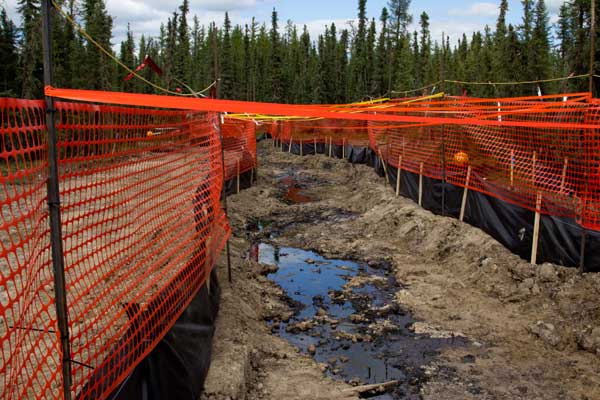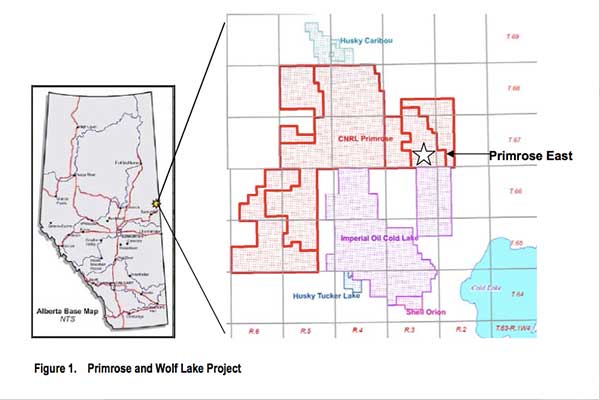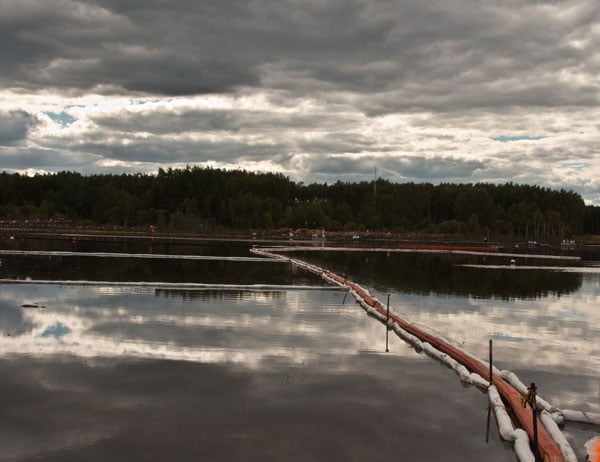A major oil-sands company has been ordered by the Alberta government to drain two-thirds of a shallow 53-hectare lake in northern Alberta.
The order follows on the heels of several significant blowouts early this summer at Canadian Natural Resources Ltd.'s (CNRL) Primrose field at Cold Lake Air Weapons Range.
Seeping bitumen from three well sites contaminated 20 hectares of muskeg and killed numerous wildlife with more than 10,000 barrels of bitumen mixed with water.
The bitumen seepage at the lake is located just 10 kilometres from those previous uncontained releases and occurred in late June. The leak also created a 30-metre long fissure under the lake.
These events illustrate the fragility of so-called in-situ production, or what government and industry advertise as the safe and environmentally friendly future of oil-sands production in contrast to open pit mines.
In-situ or steam-assisted production exploits deep deposits of bitumen, 75 metres or deeper, by heating lard-like formations of the junk crude with waves or pulses of steam. On average it takes more than three barrels of steam to produce one barrel of bitumen.
CNRL uses a process called high pressure cyclic steaming at Primrose, which steams, soaks and then pumps the melted bitumen over a series of weeks. Other companies heat the top of formations and then collect melted bitumen using a gravity system.
In 2009, CNRL had a major leak near the present bitumen ruptures, but stopped injecting steam and depressurized the formation as soon as it found bitumen leaking on the forest floor.
That event, which contaminated the Bonnyville Aquifer, released 12,000 barrels of bitumen and wasn't reported to the public until 2013.
Neither CNRL or the regulator communicated the scale of the event in early summer. The company, which does not have a media spokesperson, seemed reluctant or unable to provide timely information. Or as CNRL President Steve Laut put it: "In hindsight we should have come out with more information sooner, but we thought that the regulator was providing that information."
According to one independent geologist who requested anonymity, the new leakages occurred very close to the 2009 incident. CNRL was "allowed to eventually ramp up the steam to the original pressure that caused the failure in the first place," said the geologist. "This was done over a period of time and in stages of pressure increases. One of the new releases looks to be within a couple of hundred meters of the 2009 incident."*
On June 24, a fourth leak appeared underneath a lake that CNRL has now been ordered to drain and clean up by the Alberta government.
The energy regulator didn't demand that CNRL lower its steam pressures at its Primrose facilities until July.
The regulator says it does not know what caused any of the four leaks and is looking "forward to reviewing CNRL's information supporting their conclusions on the root cause of the releases."
Lost bitumen
CNRL, one of Canada's largest oil and gas producers and a significant bitumen player, says that mechanical failures or leaky wellbores are the problem, because they act as holes in the barrier of the cap rock. The company reported 18 leaking wellbore casings in 2013.
But geologists and other scientists suspect the company has broken the cap rock by injecting too much steam.

"You can fix a wellbore, but you can't repair a fractured cap rock," explained the geologist. "You have to reduce pressure which means producing less bitumen. But I suspect wellbore integrity is part of the problem too."
There are other unanswered questions, according to independent Alberta-based scientist Kevin Timoney.
"We don't know how much bitumen has been lost underground or how much has connected to groundwater and other formations," Timoney said.
Groundwater in the region, which is dotted with steam plants, discharges into water bodies such as Cold Lake.
After the 2009 incident, the regulator noted "there remains uncertainty about how the bitumen emulsion will break down over time with heat from further steam injection and about what constituents may be released into the Bonnyville Aquifer."
Together with Peter Lee of Global Forest Watch, Timoney put together a 63-page bulletin on the bitumen release in the public interest a week ago.
The report, which the two scientists wrote for free, criticizes CNRL and the regulator for not providing timely information on the incident or mentioning the importance of maintaining cap rock integrity in the region.
"If they have damaged the cap rock, bitumen contamination could not only destroy groundwater and surface water but compromise the value of the resource itself. Billions of dollars worth of the resource could be at risk," Timoney said.
Added the scientist, a critic of rapid oil-sands development: "There appears to be a new kind of significant incident in the tar sands that the public knows little about. Industry has a big problem and they are trying to make it go away, and as usual we live behind an oil curtain of secrecy in this province."
Steam, baby, steam
The Alberta government's new department of Environment and Sustainable Resource Development has now ordered the company to drain water "from a bitumen-affected water body before it freezes, so permanent containment measures can be put in place during the winter."
About 122 steam-assisted projects now account for nearly half of the 1.7 million barrels of bitumen produced a day in Alberta, while some of the world's largest open pit mines produce the rest.
Steam plants use three times more natural gas than the mines and produce three times more greenhouse gas emissions. They also impose a larger impact on the landscape when natural gas drilling and hydraulic fracturing are included in the production footprint.
Due to the large volume of natural gas consumed by the steam plants, the energy returns from this production method are low and comparable to bio-fuels like ethanol.
According to CNRL, its Primrose East and South facilities consist of nearly 200 wells that produce about 50,000 barrels of bitumen a day and are "the most profitable in-situ production in Canada."

Incidents at bitumen steam plants can be dramatic and occur much more frequently than are reported by industry or the regulator.
In 2006, Total, a French multinational company, over-pressurized one bitumen formation north of Fort McMurray.
The accident allowed the steam to create or find a fracture in the cap rock and then blew to the surface. The resulting explosion created a 300-metre hole in the forest. The Alberta Energy Regulator described the explosion as a "catastrophic event" but didn't publicly report on the matter for four years.
"Industry guys talk about entire well pads shifting or a well pad collapsing into the ground into a cavern. There have been dozens and dozens of these incidents that the public and investors are not aware of," said the independent geologist.
In response to the growing number of "events", the regulator set up an Oil Sands Cap Rock Integrity Project (ORSID) in 2009 to "assess the potential risk for human-induced geological hazards" in the oil sands.
The project was intended to look at the integrity of rocks overlaying bitumen formations to ensure "their capacity to contain steam, bitumen and formation water when subjected to high temperature and/or high pressure operating conditions."
But to date, ORSID has not released any reports on its website. Nor has it released a database of incidents involving steamed bitumen production.
The website for ORSID explains that "uncontrolled releases of steam, oil or formation water caused by in-situ oil production (e.g. cyclic-steam stimulation and steam-assisted gravity drainage) create concerns for resource and environmental conservation."
In 2012 industry produced a map highlighting areas in northern Alberta "where cap rock integrity may be a significant risk for typical [steam-assisted gravity drainage] operations."
After the 2009 bitumen seepage incident, neither CNRL nor the regulator could agree on the cause.
The regulator's report released in 2013 concluded "the cause of the release from the Clearwater reservoir cannot be determined with certainty from the available data. Canadian Natural concludes that the release may be the result of the confluence of a geologic weakness and operational stresses."
"It's possible that a pre-existing fracture caused the 2009 spill," said conservation specialist Carolyn Campbell with the Alberta Wilderness Association.
"I think the Primrose event shows that the regulator is not able to manage the risk of these highly-pressured steam operations in an area of proven geological weaknesses."
Those weaknesses include a collapsing salt fault.
*Story corrected Sept. 25 at 1:50 p.m. A Tyee source was presented with new information. ![]()
Read more: Energy, Environment

















Tyee Commenting Guidelines
Comments that violate guidelines risk being deleted, and violations may result in a temporary or permanent user ban. Maintain the spirit of good conversation to stay in the discussion.
*Please note The Tyee is not a forum for spreading misinformation about COVID-19, denying its existence or minimizing its risk to public health.
Do:
Do not: